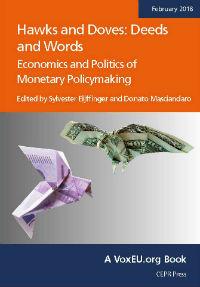
Monetary Policy in the Age of Transparency
AN EBOOK EDITED BY SYLVESTER EIJFFINGER AND DONATO MASCIANDARO EXPLAINS HOW MONETARY POLICY DECISIONS ARE TAKEN AND HOW THESE AFFECT MARKETS THROUGH CENTRAL BANKS' COMMUNICATION STRATEGIESBocconi Knowledge, courtesy of CEPR Press, publishes an excerpt from the introduction to "Hawks and Doves: Deeds and Words. Economics and Politics of Monetary Policymaking", edited by Sylvester Eijffinger (Tilburg University) and Donato Masciandaro (Bocconi University), a CEPR Press eBook, available at this link
The role of the monetary policy decisions in influencing markets and economies has increased sharply over the past 30 years, mainly driven by the recommendations of economic theory and the efforts of policymakers to improve central banking institutions. Two recent evolutions in the research on monetary policy decisions are the analysis of the mechanisms that govern the production of such decisions, and the analysis of their distribution, i.e. the fields of monetary policy governance and monetary policy communication. Deeds and words are two sides of the same coin.
On one side, the monetary policy setting has been characterised by the widespread establishment of monetary policy committees (MPCs), a process which started in the late 1990s. The issue of MPCs is related to various dimensions of monetary policymaking: differences between individual and committee decisions; strategic interactions among members; their potential differences in terms of preferences, private information, and goals; potential problems of free riding, and so on. One additional aspect that has recently been integrated into MPC decisions is behavioural economics. On the other side, there is increasing evidence of the growing importance of the links between monetary policy decisions and communication in influencing the overall effectiveness of monetary actions in modern economies.
 Up until the 1980s, central banks were very much shrouded in monetary mystique and secrecy. The development of the modern theory of monetary policy – based on the intertwined concepts of rules in policy on the one hand, and independence and accountability of the policymaker on the other – produced a natural change in communication prescriptions from secrecy to transparency. Discretion and ambiguity in monetary policy were abandoned in favour of monetary policy rules that are explicitly announced and motivated. Transparency became a key feature of central banking policy.
Up until the 1980s, central banks were very much shrouded in monetary mystique and secrecy. The development of the modern theory of monetary policy – based on the intertwined concepts of rules in policy on the one hand, and independence and accountability of the policymaker on the other – produced a natural change in communication prescriptions from secrecy to transparency. Discretion and ambiguity in monetary policy were abandoned in favour of monetary policy rules that are explicitly announced and motivated. Transparency became a key feature of central banking policy.It has been increasingly stressed that the effectiveness of central banks in affecting the economy critically depends upon their ability to influence market expectations regarding the future path of monetary policy decisions, and not merely the current policy stance. Public understanding of current and future policy thus became critical for the success of policy. In other words, monetary policy increasingly became the art of managing expectations via effective communication strategies.
The aim of this eBook is to present the state of art of the economics and politics of modern monetary policy governance as a story of two parallel and intertwined tales: the tale of how monetary policy decisions are reached, and the tale of how such decisions can influence the shape of the markets via central bank communication policies.
by Sylvester Eijffinger and Donato Masciandaro
